Astonishing beauty, graceful demeanor, and wolf-like features are among the first things that come to mind when thinking of Huskies.
But, there is so much more to this increasingly popular breed. Huskies are brave, loyal, and intelligent.
They are great with kids, excellent home protectors, and loyal friends. Once bred as sled dogs, nowadays huskies are one of the most popular family breeds.
Still, they can be a handful. Huskies are very energetic and active and share some characteristics of their wolf ancestors.
They prefer outdoors and colder weather, shed a lot, and demand a lot of attention.
If you want a dog with these qualities, but for some of these reasons, you feel that this northern breed may not be right for you, there are plenty of dogs like huskies out there that share some of their traits, but slightly differ in appearance, temperament or climate preferences.
To help you get a clearer picture, we have prepared a list of Husky lookalikes you might want to consider.
Table of Contents
What Characteristics Do Dogs Like Huskies Share?
Most of the dogs on our list share northern origins and were bred in colder parts of the world, such as Siberia, Northern Europe, Canada, or Alaska.
This makes them prefer the lower temperatures, but some of these breeds are now well adapted to living in warmer conditions.
According to the AKC website, most of these breeds were used as sled dogs, so hundreds of years of living in tough surroundings and working hard have made these breeds very resilient, so they are generally very healthy and will require less vet care.
As for the appearance, most of them have a broad chest, pointed ears, a thick double coat, and significant size, although there are some husky-like breeds of smaller height and weight.
The fur color changes from white and gray to copper red, brown, and black. Since these are mostly working breeds, at least by origin, they tend to be very active and need stimulation and exercise.
The List of Dogs Like Huskies
Alaskan Malamute
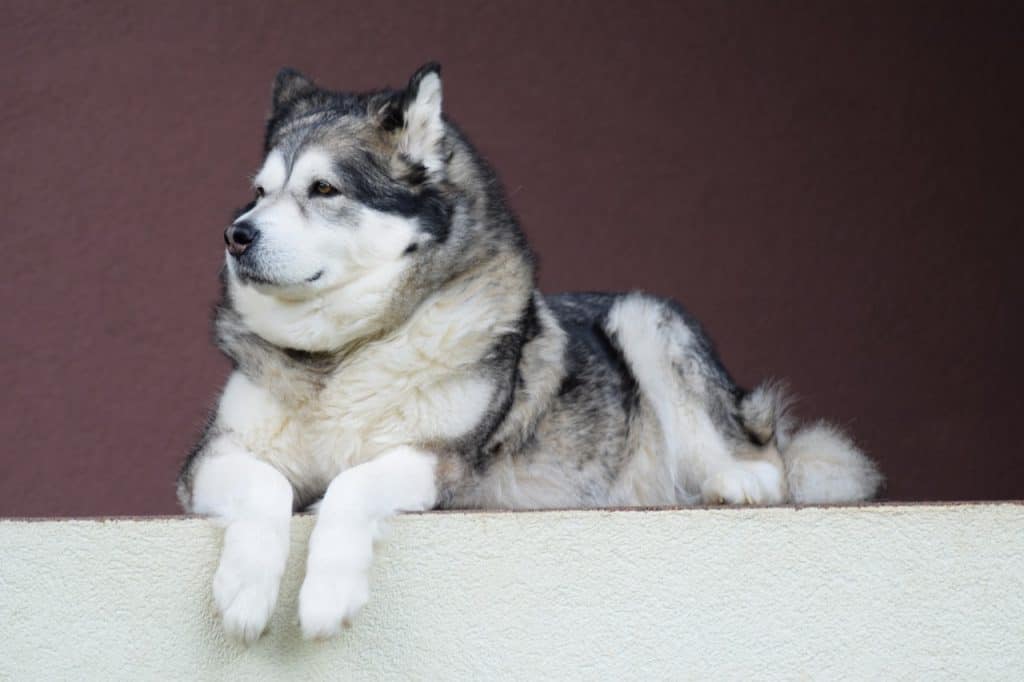
As their name says Malamuts originate from Alaska and are descendants of the actual wolves. Originally they were raised as hunters’ companions but later were mostly utilized as sled dogs.
They look very similar to huskies but are somewhat bigger and stronger. Their face is mostly white, with color on the top of the head, and their body coloring is more muted compared to Huskies.
Also, they tend to shed a lot more than Huskies. Males usually grow from 25 to 27 inches, while the size of females ranges from 23 to 25 inches.
Grown Male Malamutes weigh around 85lbs, and females are a bit lighter at about 75 pounds. Their expected life span is around 12 years.
Malamutes are known for their fitness and endurance, and they will require much more exercise and outdoor activity than an average dog.
They are friendly, kind to the kids, and loyal, but can a bit get destructive if they are bored and left alone for too long.
If you like long hikes and nature outings, the Malamute may be a perfect dog for you, especially since, due to exceptional strength, it can carry its own backpack.
They do have a reputation for being stubborn, but with proper training, they will easily fit into your family.
Samoyed
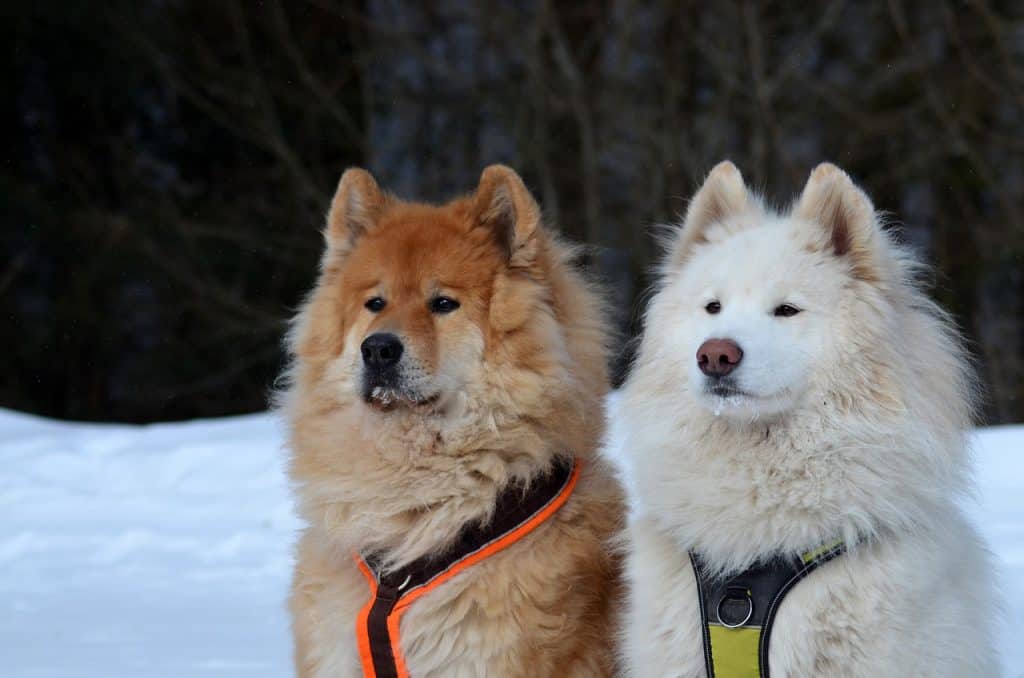
One of the oldest dog breeds, Samoyeds have accompanied Siberian nomads and hunters for thousands of years.
They are even named after Siberian indigenous Samoyede people. These dogs served as protectors, sled dogs, and even assisted in deer hunting.
Samoyeds are thicker than the Huskies and have all-white lush fluffy fur. They are also more vocal and tend to bark and howl more.
The average height of the Samoyed is about 23 inches for males and up to 21 inches for females. Their weight is in the range from 44 to 55lbs. The life expectancy is about 13 years.
Contemporary Samoyeds are still energetic and due to their work genes, want to be occupied almost all the time. But they are also very social, friendly, and kind to children.
You can even keep them in a larger apartment if you commit to often going out for walks. Since Samoyeds are hunters and workers by nature, they make excellent companions for many outdoor activities.
In addition, they are extremely smart dogs and react positively to training.
Alaskan Klee Kai
The Alaskan Klee Kai is a relatively new breed, developed in the 1970s. Their main purpose from the start was companionship rather than work.
They are direct descendants of Alaskan and Siberian Huskies and in many ways are a mini version of a Husky.
They even share similar coat markings and face features, so much so that they are often mistaken for Husky puppies.
They are considerably smaller and grow only up to 17 inches (16 for females) and can weigh up to 20lbs.
The typical life span is from 15 to 18 years.
Klee Kais are friendly, kind to the kids, and loyal to their family. However, they are rather shy and distrustful to strangers.
This, despite their small size, make them useful as watchdogs. They are fairly vocal and enjoy playtime with humans.
Klee Kais are very intelligent, and if left unattended they will try to entertain themselves and even figure out creative ways to escape or get destructive, so make sure you keep a close eye on them.
Tamaskan
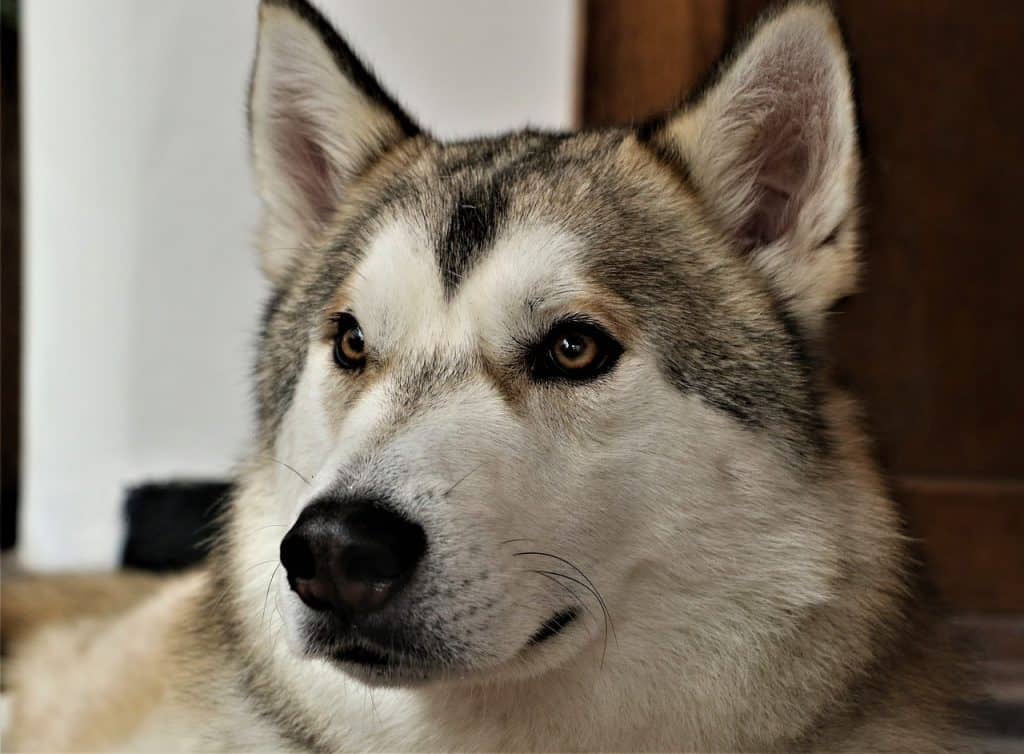
Originating from Finland, the Tamaskan Dog is a mix of Siberian Husky, German Shepherd, Malamutes, and some other breeds.
They are still a relatively rare breed, developed in the 1980s, and officially recognized as recently as 2013.
Their appearance may first remind you of wolves, but their temperament and personality are similar to Huskies.
They are easier to keep since they don’t shed as much.
Tamaskans are also similar to huskies in size, even a bit larger, with males growing up to 25 inches and females up to 26.
The weight of males varies between 66 and 99lbs, while the females are about 10 lbs lighter on average.
The life span of Tamaskans is up to 15 years.
Due to their sled pulling and work dog origins, the Tamaskans are very athletic and energetic dogs.
Also, they respond very well to training and are very loyal and social.
Due to their high level of energy and size, you may not want to keep them in the apartment, or you could be facing a proper mess the first chance they’re left alone.
They adore kids and love playing around with them as well.
American Akita
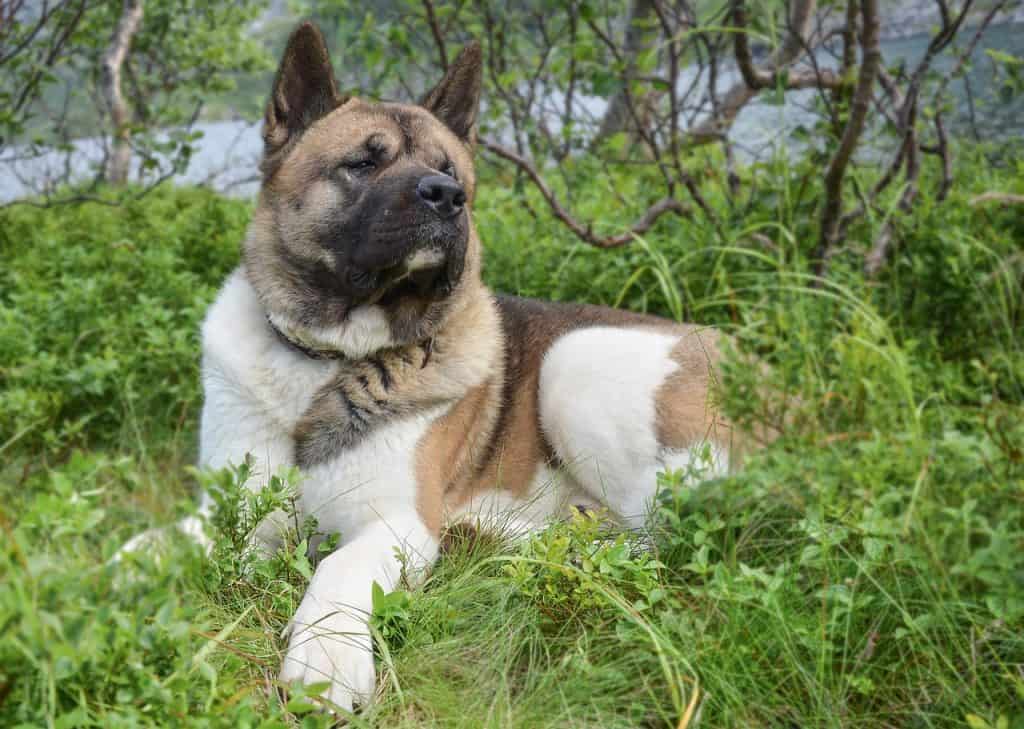
Developed in Japan in the 1600s, Akita dogs had a reputation as fearless watchdogs and hunters for centuries.
Their original purpose was to be a guard dog for royals, but they were also used for hunting large animals such as boars and bears.
Although their appearance is similar to Huskies, Akitas are much larger and burlier.
The male height varies from 26 to 28 inches, and females are a bit shorter and grow from 24 to 26 inches. They are one of the heaviest dogs in this group, and males can weigh up to 130lbs.
Even though they don’t serve royalties any more, their guarding instincts are still strong.
Akitas show utmost respect and love for their owners, while they are wary of strangers, even to the point where they can get overprotective.
Still, thanks to their high intelligence, they can be trained to reduce their aggressive behavior towards strangers.
Within the family, they are social and enjoy spending time with kids. Unlike other dogs like huskies, they don’t require an excessive amount of exercise, so you can train them to be suitable for apartment life.
Utonagan
The Utanogan is another newish breed, developed in the 1980s by Edwina Harrison. They feature a combination of genes from Siberian Husky, German Shepherd, and Alaskan Malamutes.
They look much Huskies but are larger and heavier, and most closely resemble the actual wolves.
Adult males’ height is between 26 and 30 inches, and females can reach a height from 23 to 26 inches.
Male Utonagan dogs weigh between 85 and 110lbs, while females are usually between 55 and 85lbs. They live up to 15 years.
Despite its sometimes frightening wolf-like appearance, Utonagan is a kind and friendly breed.
They have a jolly and lively outlook and enjoy spending time and playing with kids. However, to keep them happy, you’ll have to provide them with a lot of attention and stimulation.
For this breed, daily physical activity is a must. They also enjoy mental simulation, and various games, toys, and tricks.
Utonagans, love big and open spaces, if you keep them in an apartment they may become nervous and anxious over time.
They can also serve you as a guard or work dog, and you can easily train them for these tasks.
American Eskimo
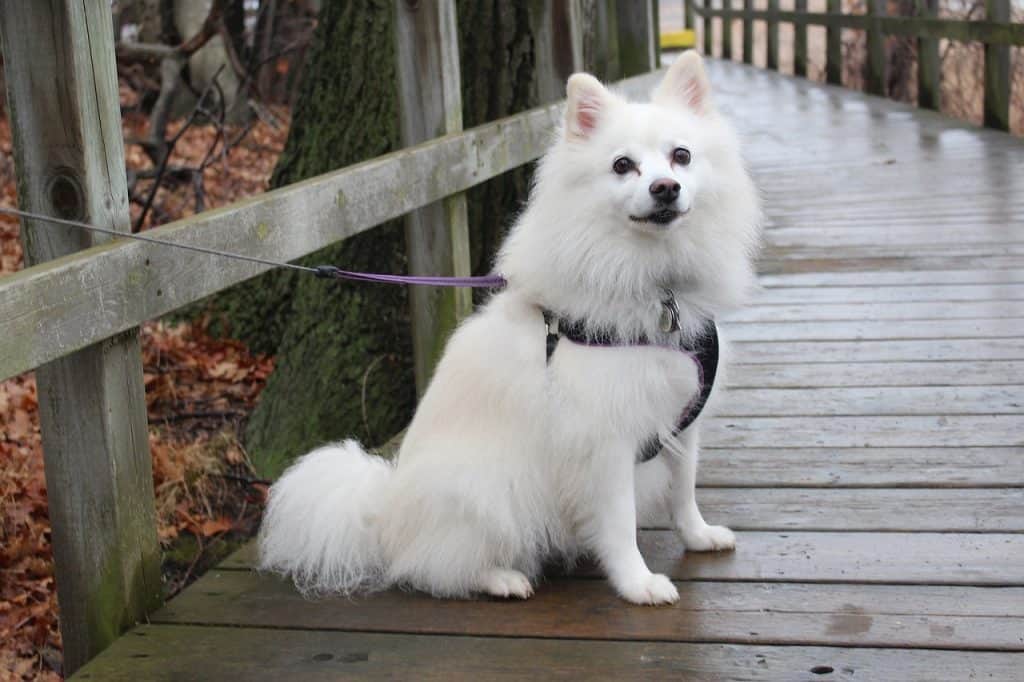
The origins of the American Eskimo breed can be traced back to the white German Spitzes that came to the US with Germa immigrants in the early 1900s.
This connection to the Spitzes makes them smaller than the Huskies, although they share similar facial and body features.
The most distinguishing feature is a fluffy all-white coat. In a way, they remind me of Samoyeds a lot.
Males can only grow up to 19 inches and females’ maximum height is 17 inches. They also don’t weigh much – males around 35lbs, females closer to 30lbs.
The common life span is approximately 15 years.
The American Eskimo is a lively and curious breed that constantly seeks attention. The lack of activity can lead to some problematic behavior, but otherwise, they enjoy spending time with family and kids, especially.
American Eskimo dogs can be somewhat aggressive to strangers, so you’ll need to do some training in this regard.
Their intelligence and willingness to learn various tricks makes them perfect for dog sports and were often used in circuses.
Saarloos Wolfdog
The person responsible for this breed is the Dutch breeder Saarloos Leendert who combined German Shepherd and wolf in the first half of the 20th century to get this husky lookalike.
Their appearance is somewhere between a wolf and a husky and similar to huskies they tend to shed a lot.
Saarloos wolfdogs are slightly larger than huskies and males grow between 26 and 30 inches. Females commonly reach the height between 24 and 28 inches.
Their maximum weight is around 100lbs for males and 80lbs for females.
This breed can live up to 12 years.
Developed as work dogs, Saarloos wolfdogs are very energetic, strong, and independent. They are strong-willed, but show plenty of loyalty and obedience to the owner.
They are not overly aggressive, but rather shy and suspicious towards strangers. However, if you have kids, the Saarloos Wolfdog may not be the best dog for you.
Due to wolf genes, they have a high predatory drive and it can be unsafe to leave them with children without supervision.
Czech (Czechoslovakian) Wolfdog
Among the dogs like Huskies, this is another breed with the wolf lineage. Czech Wolfdogs were developed in the 1950s, as a mix between the German Shepherd and Carpathian wolf.
Their original purpose was to be guard dogs and was intended for use in the Czechoslovakian armed forces.
They have strength and stamina similar to Huskies, which is understandable since they are both descended from wolves.
They are a bit larger though, with males reaching 30 inches of height and females that grow up to 28 inches. Their average weight is around 60lbs for males and 47lbs for females.
The expected life span is about 14 years.
Czech wolfdogs are fearless and independent. While they are loyal to their owner, they are very suspicious and sometimes aggressive towards strangers.
Due to their temperament, they can easily attack when provoked. This all means that if you choose to get this breed, some serious and thorough training will be necessary.
Although they can be playful, similar to the Saarloos Wolfdogs, that may be best for families without children.
They are best kept in large yards or similar open spaces where they can roam freely and get their daily exercise.
Finnish Spitz
This is another breed that was developed in Finland with the main purpose of hunting wild game.
When it comes to dogs like huskies, this one is least likely to be mistaken for its relative, mostly due to the distinctive golden-red shades of its coat.
Also, they are significantly smaller than huskies. Males don’t grow more than 20 inches and the females’ maximum is 18 inches. Finish spitzes weigh only up to 35lbs for males and 30 lbs for females.
Their life expectancy is around 15 years.
Finnis Spitz’s hunting qualities mean that it’s active, alert, and often vocal. Besides hunting, they enjoy and excel in various sporting activities.
Their bravery also makes them suitable if you’re looking for a watch dog for your family. All of this doesn’t mean that they are aggressive, on contrary, they are friendly and loyal, and are great dogs to have around kids.
Their size may make them seem like ideal dogs for an apartment, but they do bark a lot so your neighbors may not be too happy about it.
Icelandic Sheepdog
The history of Icelandic Sheepdogs goes all the way to ancient Vikings.
This breed was used for herding sheep by Icelandic inhabitants at the time. They are also part of a Spitz family and carry a lot of features similar to Huskies.
They have pointy ears, thick coat, and a wolf-like face. They don’t grow to be very large, males go up to 20 inches, and females up to 18 inches.
Males and females weigh up to 30 and 28lbs, respectively. Also, they usually live up to 15 years.
As is the case with other sheep herding dogs, Icelandic sheepdogs are incredibly active and full of energy.
They enjoy all kinds of activities and demand a lot of attention in this sense. Their intelligence and friendliness make them easy to train.
Bear in mind that they can get easily bored and destructive if they don’t receive enough attention and exercise.
Due to their shepherd nature, they don’t always get along with other dogs and are wary of strangers.
Northern Inuits
Northern Inuits were bred to resemble wolves and do indeed look a lot like them, but do not possess any wolf genes.
They were developed by crossbreeding Inuit dogs, German Shepherds, and Siberian Huskies.
They are similar to huskies in build and coloring, only a bit smaller.
Males grow up to 32 inches, while the females are significantly smaller and can have a maximum height of 28inches. Males usually weigh from 80 to 110lbs, and the females are closer to the range of 55 to 80lbs.
The Northern Inuits are smart and athletic, with excellent stamina and a sense of smell, which is why they’re often used as police dogs.
Also, they can be rather stubborn and difficult to train, so if you’re an inexperienced owner, you may be better off with some other breeds.
Still, if you are able to train them properly and can spare a lot of attention and time they make wonderful and loyal companions.
They get along with and like children, although their occasional recklessness can make them a hazard around toddlers.
